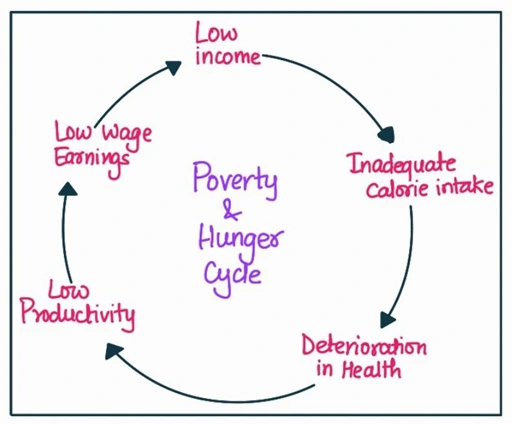Answer:
| Approach:
Introduction
- Introduce the challenges of hunger and poverty in India and their significance in the context of good governance.
Body
- Talk about the progress made by successive governments.
- Identify the challenges in addressing hunger and poverty.
- Highlight the measures for improvement.
Conclusion
- Conclude, emphasizing the need for a combination of improved implementation, targeted interventions, and collaborative efforts to ensure good governance in addressing these critical issues.
|
Introduction:
Despite India’s economic progress, it grapples with severe hunger and poverty issues. The 2022 Global Hunger Index places India at 107 out of 121 countries, with the world’s highest child wasting rate at 19.3%. Concurrently, although poverty rates have decreased over the years, the pandemic’s impact suggests a potential rise, with a significant portion of the population still living in extreme poverty. These persistent challenges underscore the need for comprehensive and inclusive policies.

Body:
Progress made by successive governments:
- Economic growth: According to the World Bank, the percentage of people living in extreme poverty has significantly decreased since the 1990s.
- Social welfare programs: Governments have implemented various social welfare programs aimed at alleviating poverty and hunger, such as the Mahatma Gandhi National Rural Employment Guarantee Act (MGNREGA), which guarantees 100 days of wage employment per year to rural households, and the Public Distribution System (PDS), which provides subsidized food grains to vulnerable populations.
- Poverty alleviation schemes: Numerous poverty alleviation schemes have been launched, such as the Pradhan Mantri Awas Yojana (PMAY) for affordable housing, and the Pradhan Mantri Jan Dhan Yojana (PMJDY) for financial inclusion.
- Focus on agriculture: Efforts have been made to boost agricultural productivity and income through initiatives like the Pradhan Mantri Krishi Sinchayee Yojana (PMKSY) and Pradhan Mantri Fasal Bima Yojana (PMFBY).
Despite these efforts, hunger and poverty continue to persist in India due to various reasons, such as inadequate implementation, lack of resources, and population growth.
Measures for improvement:
- Strengthening social welfare programs: It is crucial to improve the implementation and monitoring of social welfare programs like MGNREGA and PDS to ensure that benefits reach the intended beneficiaries.
- Enhancing agricultural productivity: Investing in agricultural research, extension services, and infrastructure can help increase productivity, generate income, and reduce poverty.
- Skill development and employment generation: Creating employment opportunities and promoting skill development can help uplift people out of poverty and reduce hunger.
- Universal social security coverage: Ensuring universal access to social security benefits, such as pensions, healthcare, and insurance, can help protect vulnerable populations from falling into poverty.
- Targeted poverty alleviation schemes: Implementing targeted poverty alleviation schemes based on accurate data and identification of beneficiaries can help maximize the impact of government efforts.
- Public-private partnerships: Encouraging partnerships between the government, private sector, and civil society organizations can help mobilize resources and expertise to address hunger and poverty more effectively.
Conclusion:
While successive governments have made progress in dealing with hunger and poverty, significant challenges remain. A combination of improved implementation, targeted interventions, and collaborative efforts can help India overcome these hurdles and ensure good governance in addressing these critical issues.
